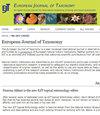Additions and corrections to taxonomy of Apobaetis fiuzai Salles & Lugo-Ortiz, 2002 and Apobaetis kallawaya Nieto, 2006 (Ephemeroptera, Baetidae)
IF 1.3
3区 生物学
Q3 ENTOMOLOGY
引用次数: 0
Abstract
Recently, it has been hypothesized that the wide distribution of A. fiuzai Salles & Lugo-Ortiz is due to a wide diagnosis and conflicting keys. The same arguments can be applied to A. kallawaya Nieto. In order to test this hypothesis, we revised the type material of A. fiuzai, literature of A. kallawaya, and part of the recorded specimens in Brazil. As a result, three new species from previous records are recognized: Apobaetis pasternakae sp. nov., former A. fiuzai in Amazonas, Roraima and Maranhão states; Apobaetis jaquelinae sp. nov., former A. fiuzai in Rondônia State; Apobaetis luanae sp. nov., former A. kallawaya in Rondônia State. The new data showed that A. fiuzai does not occur in the Amazon Biome and A. kallawaya does not occur in Brazil. Records of A. fiuzai that could not be reviewed in this study are treated as putative and should be evaluated in the light of the new evidence. We also studied the intraspecific variation in A. fiuzai and A. pasternakae sp. nov. The pigment pattern of the nymphs was not considered a robust characteristic for the species differentiation due to the wide variation in and between populations, and interspecific similarity of many features. On the other hand, classical morphological characters such as mouthparts, legs, spines of terga, paraproct and caudal filaments have minimal variation, stable and reliable for specific identification.Apobaetis fiuzai Salles和Lugo Ortiz,2002和Apobaeti kallawaya Nieto,2006分类法的增补和更正(Ephemeroptera,Baetidae)
最近,人们提出了一种假设,认为a . fiuzai Salles & Lugo-Ortiz的广泛分布是由于广泛的诊断和冲突的钥匙。同样的论点也适用于A.卡拉瓦亚·涅托。为了验证这一假设,我们对A. fiuzai的类型资料、A. kallawaya的文献以及部分巴西记录标本进行了修订。结果发现了3个新种:Apobaetis pasternakae sp. nov.,原a . fiuzai,分布于亚马逊州、罗莱马州和马兰州;Rondônia州褐叶蝉(Apobaetis jaquelinae sp. 11 .);Rondônia州原A. kallawaya。新的数据表明,A. fiuzai不存在于亚马逊生物群中,A. kallawaya也不存在于巴西。在本研究中未被审查的记录被视为推测,并应根据新的证据进行评估。此外,我们还研究了福建田鼠和帕斯特纳科田鼠的种内差异。由于种群内和种群间的差异很大,而且许多特征在种间相似,若虫的色素模式不被认为是物种分化的有力特征。另一方面,口器、足、刺、副毛、尾丝等经典形态特征变化最小,稳定可靠,可用于特异性鉴定。
本文章由计算机程序翻译,如有差异,请以英文原文为准。
求助全文
约1分钟内获得全文
求助全文
来源期刊

European journal of taxonomy
ZOOLOGY-
CiteScore
2.30
自引率
8.30%
发文量
173
审稿时长
29 weeks
期刊介绍:
EJT is a fully refereed, international, fully electronic Open Access journal in descriptive taxonomy, covering subjects in zoology, entomology, botany (in its broadest sense), and palaeontology. EJT-papers must be original and adhere to high scientific (content) and technical (language, artwork, etc.) standards. Manuscripts that are clearly substandard in either of these categories will not be sent out for review. EJT is supported by a consortium of European Natural History Institutes, but its scope is global. Both authorship and geographical region of study need not be European. Authors are, however, strongly encouraged to involve European Natural History collections by consulting material or by depositing specimens (e.g. types and figured material) related to their published paper in the collection of a European Natural History Institute.
 求助内容:
求助内容: 应助结果提醒方式:
应助结果提醒方式:


